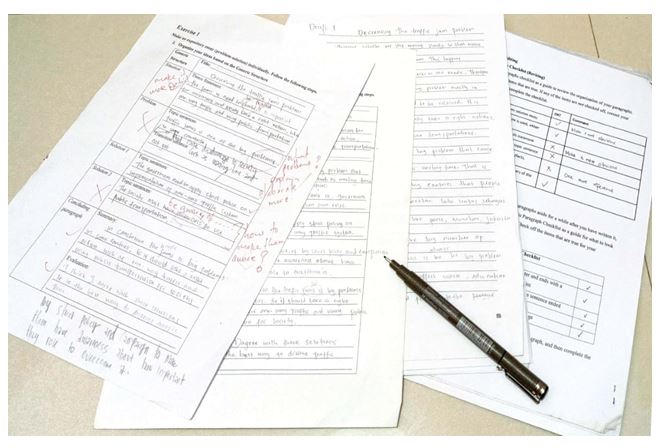Promoting Students' Autonomous Learning Using Portfolio Assessment in EFL Writing Class
DOI:
https://doi.org/10.21070/jees.v5i1.379Keywords:
portfolio assessment, students' autonomous learning, EFLAbstract
This study attempts to present the implementation of portfolio assessment to promote students’ autonomous learning in one of reputable universities in Indonesia. The participants were 30 students enrolled Essay Writing Class. A collection of students’ work during the course in the form of ‘Essay Writing Module’ was used to provide authentic evidence of the implementation of portfolio assessment and observation checklists of students’ work was used to present the completeness of portfolio assessment of each student. To know students’ autonomous learning, semi-structured interview was carried out. The results prove that portfolio assessment can promote students autonomous learning since it provides some benefits for students such as motivate them to do self-evaluation and reflection, encourage them to be actively involved in peer review session, and also enhance their awareness of their weaknesses.
HIGHLIGHTS:
- Portfolio assessment promotes students’ autonomous learning by providing some benefits for students such as provide a guide for self-evaluation, reflection, and peer review.
- Each element in portfolio encourages students’ engagement during the writing activities both inside and outside the classroom.
- An insightful idea of specific criteria motivates students to set goals in improving their writing competence and performance.
Downloads
References
Aydin, S. (2010). EFL writers’ perceptions of portfolio keeping. Assessing Writing, 15(3):194–203.
Boardman, C. A. and Frydenberg, J. (2002). Writing to communicate: paragraphs and essays. New York. Pearson Education Inc.
Brown, H. (2007). Teaching by principles: An interactive approach to English pedagogy. Pearson Education ESL.
Ceylan, N. O. (2015). Fostering Learner Autonomy. Procedia - Social and Behavioral Sciences, 199:85–93.
Chan, V. (2003). Autonomous language learning: The teachers’ perspectives. Teaching in Higher Education, 8(1):33–54.
Chang, C. C., Tseng, K. H., Liang, C., and Chen, T. Y. (2013). Using e-portfolios to facilitate university students’ knowledge management performance: E-portfolio vs. non-portfolio. Computers & Education, 69:216–224.
Emaliana, I., Tyas, P. A., Widyaningsih, G. E. N., and Khotimah, S. K. (2019). Evaluasi Pembelajaran Bahasa Asing pada Pendidikan Tinggi. Universitas Brawijaya Press.
Ilke Büyükduman, . and Şirin, S. (2010). Learning portfolio (LP) to enhance constructivism and student autonomy. Procedia - Social and Behavioral Sciences, 3:55–61.
Khonbi, Z. and Sadeghi, K. (2012). The Effect of Assessment Type (self vs. peer vs. teacher) on Iranian University EFL Students’ Course Achievement. Language Testing in Asia, 2(4):47–47.
Lam, R. (2013). Two portfolio systems: EFL students’ perceptions of writing ability, text improvement, and feedback. Assessing Writing, 132(153).
Nicolaidou, I. (2013). E-portfolios supporting primary students’ writing performance and peer feedback. Computers & Education, 68:404–415.
O’malley, J. and Pierce, L. (1996). Authentic Assessment for English Language Learners: Practical Approaches for Teacher. Addition-Wesley Publishing Company, Inc.
Railton, D. and Watson, P. (2005). Teaching autonomy: “Reading groups” and the development of autonomous learning practices. Active Learning in Higher Education, 6(3):182–193.
Richards, J. C. and Renandya, W. A. (2002). Methodology in Language Teaching: An Anthology of Current Practice. Cambrige University Press.
Romova, Z. and Andrew, M. (2011). Teaching and assessing academic writing via the portfolio: Benefits for learners of English as an additional language. Assessing Writing, 16(2):111–122.
Sundeen, T. H. (2014). Instructional rubrics: Effects of presentation options on writing quality. Assessing Writing, 21:74–88.
Tyas, P. (2012). The Effectiveness of Providing Students with a Scoring Guide in Teaching Writing. Unpubliashed Thesis.
Wang, W. (2014). Students’ perceptions of rubric-referenced peer feedback on EFL writing: A longitudinal inquiry. Assessing Writing, 19:80–96.
Widodo, H. P. (2008). Process-based academic essay writing instruction in an EFL context. Jurnal Bahasa Dan Seni Tahun, pages 36–36.
Yastibas, A. E. and Yastibas, G. C. (2015). The Use of E-portfolio-based Assessment to Develop Students’ Self-regulated Learning in English Language Teaching. Procedia - Social and Behavioral Sciences, 176:3–13.

Published
How to Cite
Issue
Section
License
Copyright (c) 2020 Peptia Asrining Tyas

This work is licensed under a Creative Commons Attribution 4.0 International License.







